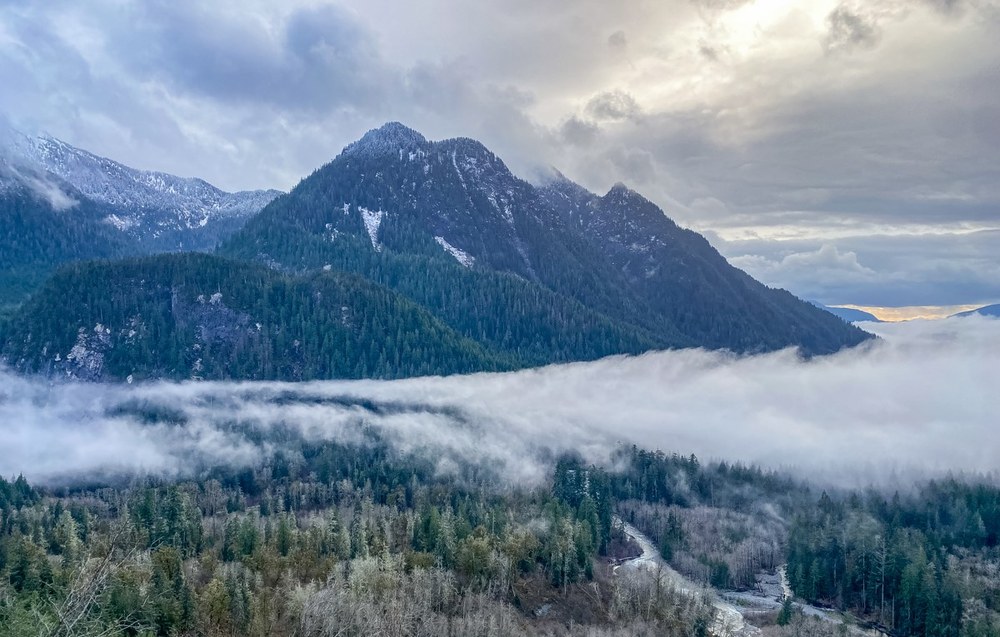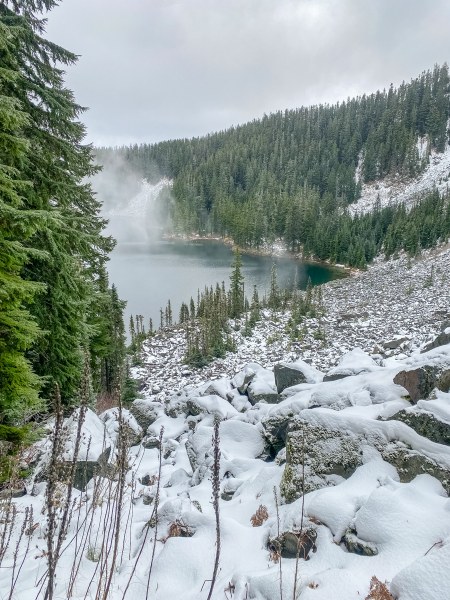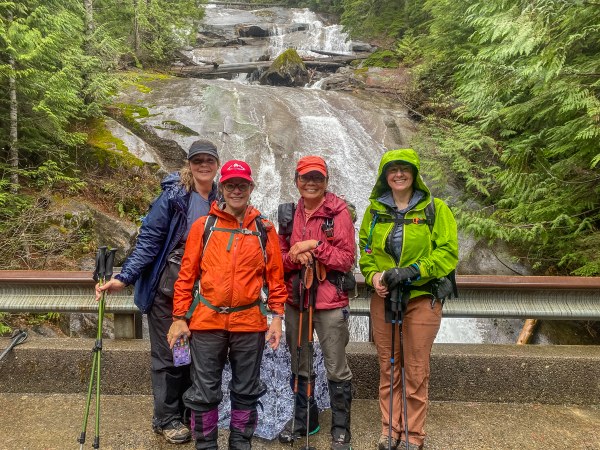
I recently escaped to the mountains on two separate occasions to seek solace. The first was November 7 when the nation awaited election results. The second was five days after a bomb cyclone left more than 600,000 people in Western Washington without electricity. Despite the contrast in challenging conditions, both outings brought opportunities for growth, joy, and peace. I hope some of the suggestions in this blog will supply you with tips for cultivating a joyful mindset when facing unusual circumstances.
Finding Solitude and Growth: The Election Day Hike
On election day, I hiked 16 miles to Thompson and Granite Lakes from the Granite Creek Trailhead. Mother Nature doled out a little of everything: rain, sleet, hail, snow, wind, and sun. While my nine-year-old dog, Ajax, has been a fantastic trail companion in recent years, I knew he couldn’t do the planned mileage. To be honest, I wasn’t even sure I could when it started to snow.
My hike included moments of joy, from selecting the right gear to connecting with nature in the first snowfall of the year. I took traction devices with me, but never needed them. I did, however, use my poles as I headed down the steep, snow-covered slopes to Thompson Lake. I also borrowed a warm waterproof layer from my husband which, paired with gaiters and waterproof boots, kept me toasty and dry in the sleet and hail. Who knew proper preparation could bring such joy?
Sleet turned to big, fluffy flakes the higher I ascended. The sinking feeling I’d felt in the rain turned to elation. I grinned, as snow is much more enjoyable to hike in than rain. “Is that all you got?” I called out to the sky.
I stopped to study several animal tracks in the fresh snow: deer, snowshoe hare, and perhaps even fox. Nature amazed me with her beauty. Over seven hours, I only encountered five other solo hikers. Were they escaping for the same reasons?
By the last mile, the sun came out to warm my back and made me feel, in that moment, that all was right with the world.
 Thompson Lake under inches of fresh snow. Photo by Courtenay Schurman.
Thompson Lake under inches of fresh snow. Photo by Courtenay Schurman.
Your Turn
I had done several 12- and 14-mile hikes in late fall, but hiking 16 miles in waning November daylight was a first. When facing adversity, can you create a solo outing that feels challenging yet manageable?
Consider writing a reflection piece before and after the outing to capture any shifts in your mindset. During your adventure, think of three things that delight you. They can be as small as a fluffy snowflake or as big as a rainbow. I delighted in a pair of downy woodpeckers chirping at each other as they foraged for bugs.
The Power of Camaraderie: Finding Community During A Mentored Hike
My second illustration of unusual circumstances was a mentored hike with The Mountaineers after a bomb cyclone blew down trees and caused massive power outages across the Seattle area. Lots of participants canceled, and I wondered whether I had enough people to continue the scheduled outing. I only needed three for the hike to count as an official Mountaineers trip. At 9:10am on November 23, five of us headed for Big Creek and Otter Falls under spitting skies. What would we find on the trail?
Fortunately, the four women who joined me were all well-prepared for the elements and we experienced a refreshing day of winter hiking. My biggest goals were twofold: to stretch beyond my introverted comfort zone and make sure everyone had fun, and to help everyone navigate high stream crossings so we could all return safely. Not only did we reach both objectives, but the small group size allowed us to connect more deeply than we might have in a larger group. I shared my gratitude for each of them at lunch, for braving the weather and bringing a spirit of adventure.
After nine miles and two waterfalls, three of us still had enough energy to visit nearby Garfield Ledges to celebrate completing my mentored lead hike. Prior to the hike, my companions felt like virtual strangers, but by the end of the day the connections between us were deeply felt.
 New friends in front of Big Creek Falls. Photo courtesy of Courtenay Schurman.
New friends in front of Big Creek Falls. Photo courtesy of Courtenay Schurman.
Your Turn
It had been years since I’d led climbs and family activities for The Mountaineers. I was nervous about hiking with strangers, but also excited for the challenge. How might you plan a group activity that pushes you outside of your comfort zone while prioritizing safety?
Consider reflecting after the hike on moments of connection and joy within your group. When having a snack or lunch during the hike, challenge each other to come up with one thing each group member contributed to the experience, or one thing you learned from your partners.
Universal Practices for Finding Joy in Unusual Circumstances
Being in the backcountry is one way to create joy during challenging times. Preparing for a trip can be a way to develop joyful anticipation. We can’t control election outcomes or storms, but we can control our gear, mindset, destination, and safety. What would a “joy checklist” look like for your next outing?
On election day, the snow muffled the sounds and turned the trail white and beautiful. I delighted in the different snow textures, from slushy in one area to icy or crunchy in others. Tracks provided evidence of people and animals who came before. Try embracing any unexpected changes and look for beauty. By seeing setbacks as opportunities, you become more adaptable and experience greater joy in the moment.
As I hiked alone on election day, I missed my dog. But I also appreciated the stark fall mountains and lakes. With companions on my mentored lead, we shared stories and took selfies. In both cases, I experienced different types of joy. How do you connect to the place or the people you’re hiking with? How might solitude or companionship enrich your experiences?
In addition to providing opportunities for reflection, physical exertion releases feel-good endorphins, whether you’re on the gentle grade of a nine-mile hike to Otter and Big Creek Falls or a strenuous 16-mile hike to Thompson and Granite Lakes. To create joy in your next outing, set a physical goal that feels challenging yet achievable.
Your Turn
Can you think of a recent adventure that taught you something about joy? If you’ve struggled in the past with an outdoor adventure, how might you cultivate a growth or joy mindset to create a more positive outcome on your next trip?
What are some “unusual circumstances” that might benefit from a new approach to wilderness adventure? How might you apply some of the exercises listed above to your situation? Share your stories of finding joy in unexpected ways in the comments below!
 Courtenay Schurman
Courtenay Schurman